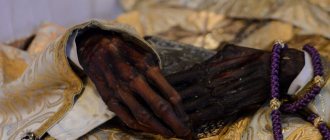ballot box, photo: social networks There are many different myths about cremating people. Some decide to leave the ashes of their deceased relatives, while others consider this approach a great sin. Combustion in a crematorium is a complex chemical process that can transform from organic human tissue into chemical compounds and mix with homogeneous soil in 1.5 hours, and not in 20 years.
Only 10% of Russians use this burial method. A small percentage argues against saying goodbye to relatives in this way. Some citizens can afford to bury themselves only this way, since it is much cheaper, and cemeteries often do not have enough space.
The topic, although unpleasant, is quite relevant. Therefore, in today's article you will get answers to 9 frequently asked questions. Dispel myths and look at the cremation process from a new angle.
- Cremation, what is it?
- What are the ashes of a deceased person?
- Does the process of cremation of people occur in 9 stages?
- Why are people cremated?
- Who works at the crematorium?
“The website “Arguments of the Week” found an interview with a crematorium worker who admitted that it was difficult for him to decide to speak publicly about the cremation process. Due to the stigmatized nature of the job, many employees are simply afraid to scare people and say something unnecessary. Dmitry, 34 years old, agreed to an interview with one of the Russian TV channels. He managed to work as a gravedigger, and then, due to moral heaviness, moved into the field of cremation. It may seem to many that the young man swapped his awl for soap, but no. Dmitry says that the process of cremation is much easier to survive than burial. After all, for him the last 10 minutes of the funeral last forever. At the crematorium, the employee does not see the tears of his relatives and performs routine work calmly.”
Cremation of relatives, what is it?
Not the best marketing describes the cremation process as a modern and environmental move with benefits for its customers. If we take the main aspects, then it is so. But the process of cremation is deciphered scientifically - the burning of bodies as a rite before burial, which takes place within the walls of a specialized crematorium building. The rules for burial in this way are simple: after cremation, the ashes of the dead are poured into funeral urns, and then the remains are buried in various ways.
Support the publication
- Join the CLAN
Or
What material should a cremation urn be made of?
Cremation urn manufacturers offer a variety of options to choose from. Cremation urns vary in the type of material used, design, and shape.
From a spiritual perspective, the following is recommended for choosing an urn:
- Material: It is best to use a clay urn to collect and store ashes. The urn should not be made of any other material such as ceramic, glass, porcelain, etc. When immersed in water, a clay urn dissolves completely in the water and hence causes little or no pollution. The Absolute Principle of the Earth is also high in it. Ash is also mainly composed of the Absolute Earth Principle. Since both belong to the same Absolute Cosmic Principle, their frequencies do not collide. Hence, clay urns are preferred.
- Design: Every type of design or art can be in sattva, raja or tama guna. Only if a person has reached a level where he can perceive purity in art or design will he be able to perceive positive or negative vibrations from the decorations on the urn. Therefore, it is recommended that the urn should not have any decorations. If the design is dominated by a subtle Raja-Tama component, it will enhance the existing Raja-Tama component in the ashes. Thus, it will cause further suffering or obstacles in the path of the subtle body of the deceased ancestor.
- Shape : Urns are made in all sorts of shapes and sizes. Typically, they are shaped like a cube, pyramid, cylinder, etc. Urns with sharp corners, as in the above examples, cause striking opposing frequencies, which are predominantly Raja-Tama frequencies. They amplify the destructive frequencies of ash. This also means adding the raja-tama component to the subtle body. Spiritual research has shown that in terms of shape, it is best to have a smooth, round, regular shape as it does not have any harmful effects on the subtle frequencies of Raja Tama.
Some cremation urn manufacturers advertise cremation jewelry that allows living relatives to store some of the ashes in some kind of bracelet or pendant. Also available are pendants where you can wear a lock of a dead person's hair, dried flowers from a funeral, or soil from a burial site. From a spiritual point of view, it is most harmful to the subtle body of the deceased person, as well as to the person wearing it. Please refer to point 4 for a full explanation of why you shouldn't do this.
To seal the urn, from the time the ashes are collected until they are finally scattered, it is best to use a white cotton cloth.
How are people cremated in a crematorium?
In a crematorium, the burning of the dead takes place in equipped engineering structures. They make it possible to turn the body and coffin into ashes due to high temperatures. The cremation temperature ranges from 900-1100 degrees, under its influence the dead person turns to dust within 2 hours.
There are 4 stages of cremation:
- The coffin and body are taken to the crematorium, where there is a farewell hall where loved ones see the deceased for the last time.
- The dead person is picked up using a conveyor and brought to the transit room. There, after waiting their turn, the body is taken to the cremation oven.
- After cremation, specialists collect the person's ashes. They put it in a funeral urn and wait for relatives to pick it up.
- Relatives of the deceased must pick up the urn within one year; if not, then it is buried in a specially separate area at the crematorium.
Is it possible to scatter the ashes?
The law of the Russian Federation does not prohibit scattering or scattering ashes on land or water. Sometimes the urn is taken to another city or even a country that the deceased loved to visit, or to places where the deceased dreamed of visiting.
Transporting hermetically sealed ashes is not difficult. The only thing you need to have with you is a certificate from the SES about sealing the capsule and documents about cremation.
An obstacle to the fulfillment of the dreams of the deceased or the wishes of a relative may be the procedure for issuing ashes by crematoriums. The law stipulates that after cremation, a person’s remains are released on the basis of a certain package of papers, including a certificate of availability of a burial place. You will have to arrange a place in the cemetery, regardless of whether relatives want to bury the urn with ashes in the ground or scatter the ashes around the territory.
In any case, it is easier to cremate a body and there are more options for making arrangements for its burial. Scattering ashes is a fairly popular procedure. It is scattered in a cemetery, on the waters of seas and rivers, in the forest, in the mountains, in a park area, under a favorite tree, in any area. Funeral agencies offer this service if you need to scatter ashes in remote areas or in memorial places.
Monuments for the grave Economical monumentEconomical monumentSmall monumentVertical monumentHorizontal monumentMonument with a crossMonument ArchDouble monumentsElite monumentChapels and calvaryMemorial complexesMarble monumentPlinth for the graveFence for the graveFlower garden for the graveTombstone Tables and benchesVases for the graveTablet for the graveDecor for the monumentK Granite restsInsert for a monumentTile for a grave
Why don't they give away the ashes right away?
It will not be possible to collect the remains of the deceased immediately, since after burning it takes at least 2 more hours for the separation process. The body is burned along with the coffin, which means that its metal parts lie together with the ashes, they must be separated. This is done thanks to a magnetic device that removes the remains of the coffin elements. After burning, the body goes into a kind of coffee grinder, turning the remains into ash. Next, the ashes are placed in a special container and placed in a funeral urn. And in the end, they pass it on to relatives. Let us remind you that you have 1 year to pick up the ballot box. 40 days will be free, and then there will be an accrual of 5 rubles per day. After a year, the urn is buried on the territory of the crematorium.
Legality of the procedure
We are often asked the question: is it possible to perform a ritual wherever they want? Are there any restrictions by law? This question often arises if a person has died from an infectious disease.
If almost no one abroad has such a question, since this tradition is not new, then for many residents of Russia, pouring out the remains in their garden or keeping it at home seems something wild and even illegal.
In fact, in Russia they do not issue official permission for you to scatter the ashes of the deceased after cremation. On the territory of our state there is an order dated January 10, 2000 No. 3 “On approval of the Instructions on the procedure for funerals and the maintenance of cemeteries in the Russian Federation.” Its essence does not permit, but does not prohibit the performance of this ritual. You have the right to dispose of the remains as you see fit, but to receive them at the crematorium you must provide the following documents:
- a certificate stating that cremation took place;
- death certificate;
- passport of the recipient/authorized person;
- documents for ownership of a cemetery plot or a niche in a columbarium.
From this it becomes clear that in any case you are obliged to buy a burial plot, and no one will control what exactly you do.
Here's everything you need to know to avoid breaking the law:
- Avoid performing the procedure near fountains, on sidewalks, near monuments and in other public places. Otherwise, you risk becoming a defendant under an article for hooliganism.
- In the cemetery, this can only be done in the Glades of Sorrow. Scattering remains on the site, even if it is yours, is prohibited.
- A deceased person close to you must, during his lifetime, record his legal will regarding such disposition of his remains. This is a basic legal procedure, without which you may be held accountable for desecration of a burial site
Cremation oven operator, who is this?
This is the name of the profession of the people who work in the crematorium. They are the ones who arrange and manage the entire cremation process. They accompany the body from entering the crematorium to giving its ashes to relatives. Operators bring the coffin with the body on a special transport and leave it near the “loading console”. After the device is connected, long arms are extended from it, the coffin is lifted from the transport and loaded into the oven. The employee turns on the oven and waits for the remaining muscle and skin to burn. The last and main step is the collection of ashes and bones. The bones are crushed using a device, turning them into dust. Next, the worker collects everything into a funeral urn, numbers it, and passes it on to relatives.
Religion attitude
Despite the fact that the procedure of burning the body of the deceased has been considered honorable from time immemorial among the Slavs, Greeks, Romans and other nationalities, Christian teaching is ambivalent about it. Catholics accepted this method of burial based on the Holy Scriptures, which recognize that the human body is made of dust and will return to it.
The Russian Orthodox Church today refuses to conduct memorial ceremonies for the deceased whose ashes were scattered. The Orthodox Church considers this disrespect for the dead. But as more and more believers turn to it, the church is preparing to reconsider its attitude, since non-acceptance has no basis.
Thus, there are no obstacles to carry out the dispelling at the request of the deceased, neither at the church, nor at the legislative or executive level. Minimal knowledge of traditions and your rights allows you to say goodbye to the departed as you and he see fit.
Is it possible not to bury in an urn after cremation?
In Russia, most often the urn is buried. But since different nationalities live in our country and there are different religions, each family says goodbye to the dead in its own way. For example, African peoples generally prefer to burn the body at the stake and place it in an urn, placing it in the most visible and honorable place in the house.
Now the trend has spread to special farewells. Loved ones scatter ashes from the shores into rivers, lakes and seas.
Those who wish to leave remains in the ground can “bury” the urn at the graves of deceased relatives. And some simply dig a small hole within the house and leave a memory of a loved one in their native territory.
Experience in Russia and abroad
This tradition came to us from our neighbors. In India, for example, ritual burning and subsequent scattering of ashes occurs in almost 80% of cases. In China, this percentage is higher than 60. Since the burial of coffins was banned in the “celestial kingdom,” this option of saying goodbye to the dead has become firmly entrenched among ritual services.
In Europe and the USA, such a person’s will not only does not surprise anyone, but is also considered quite normal for several reasons:
- Saving. In some countries, a cemetery plot or columbarium costs a lot of money. In some cases, relatives simply cannot afford a traditional funeral with expensive accessories such as wreaths, monuments, etc.
- Culture and religion. Among some peoples, faith and traditions initially suggest dealing with the dead in this way.
- Aesthetics. Some people, before death, begin to be afraid to remain lying in the cold and damp earth. Many people associate cemeteries with something very mournful and sad. The prospect of becoming ashes and not burdening relatives seems much more pleasant, noble and memorable.
- Romanticism. Many people, even during their lifetime, are attached to certain territories or objects: the house where they spent their childhood, the tree under which they met the love of their life. Therefore, they want to remain near them even after death. The idea of fulfilling the dreams of a departed person or completing his affairs is also in great demand. For example, he or she always dreamed of visiting Niagara Falls, but never got around to doing it during their lifetime.
- The desire to remove the shackles. Usually, it is guided by seriously ill and disabled people who want to be freed from this burden after death. Many people associate this condition with throwing ashes into the wind.
Among the famous people who decided to say goodbye to this world in this way are Kurt Cobain, the Strugatsky brothers, George Bernard Shaw, Yves Saint Laurent, Albert Einstein, Alfred Hitchcock and others.
Why can't you be cremated?
In practice, it is possible to be cremated, but Orthodox canons do not accept such a burial process. After all, in Orthodoxy there are divine commandments, according to which the body must remain in the ground if the relatives of the dead person are believers. Modern society thinks differently, and wants to release the ashes to freedom, and not leave them in the ground. This is a personal choice for everyone, but if you believe in a religion, then you should adhere to its rules. Also, the priests highlight a separate advantage of an earthly funeral: “You say goodbye to the scattered ashes only once, there is no one else to visit your relatives, because there is nowhere. By burying a person according to the usual rituals, the memory of a relative will definitely not fade and there will always be a place where you can go and mentally communicate with a loved one.
What do ashes look like after cremation? – it looks like black-gray ordinary ash, dust.
Are coffins burned in the crematorium? - yes, they are burned along with the dead in a special oven at a temperature of 900-1100 degrees.
Is this an oven in a crematorium? - an engineering structure that can raise the temperature to 1300 degrees, thereby burning the body and coffin within two hours.
From questions to frightening facts.
Many people are afraid that if they send their relatives to the crematorium, they will not receive their ashes. There is also a common myth that crematorium staff strip the dead and resell their expensive clothes. But it's all a lie. No one will take off the clothes of a dead man; he is plunged into the oven clothed. And the clothes are already losing their decent appearance, since sometimes you have to steam them in order to dress the dead.
As for the ballot boxes being mixed up, the probability is 2-3%. Because they make a special card for this service. It is hung on the stove immediately after loading the body. When the whole process is over, it is glued to the ballot box. The name of the dead person and the date of death are written on it.
Add AN to your sources so as not to miss important events - Yandex News
- Stas Piekha's son has a concussion and multiple bruises
- The mayor of Yalta asks Aksyonov to allow restaurants and clubs to operate after 11 p.m.
- Sejm Deputy Janina Kursite-Pakule: If 1940 happened again, there would be too many kissing tanks
- Russian military analyst Knutov: “We have actually driven NATO into a trap in Kaliningrad”
- Economist Krichevsky: all these groups of Kudrin are talking about nothing
- What do they do with clothes and is it possible to mix up the bins? 9 questions about the crematorium
- Peskov, commenting on the case of the head of the Stavropol traffic police, answered a question about corruption
Become a member of the CLAN and every Tuesday you will receive the latest issue of “Arguments of the Week” with a discount of more than 70%, along with exclusive materials not included in the newspaper. Get premium access to a library of the most interesting and popular books, as well as an archive of more than 700 published issues for FREE. In addition, you will have the opportunity to benefit from free legal advice from our experts for a whole year.
- Enter your email address, then select any convenient payment method for your annual subscription
- Scan the QR. In the Sberbank Online application that opens, enter the annual subscription cost (490 rubles). Then send the confirmation code by email
Or
Where is the best place to do this?
In Western countries, such a ceremony is treated very freely. Most often, urns are emptied:
- in the backyard of the house;
- above the water;
- under the shade of a certain tree that the deceased planted or simply loved;
- in the park.
If in our country such a funeral service is not yet so widespread and popular, then in a number of foreign countries funeral agencies can help you organize a funeral in:
- Himalayas;
- the waters of the Pacific Ocean;
- Antarctica;
- waters of the Amazon;
- Alps.
Also, architectural world heritage such as the Statue of Liberty, the Eiffel Tower, Notre Dame Cathedral, the Chinese Wall, the Egyptian Pyramids, etc. are considered very popular. It all depends on what the person dreamed of or loved during his lifetime. For example, there is evidence that at Disneyland in the USA, maintenance personnel daily have to remove ashes scattered in various corners of the family amusement park. At the same time, after cleaning it is simply thrown into a regular trash bin.
The procedure can be carried out by finding a suitable hill, or you can use a helicopter or plane. This service is available in all foreign agencies, but the price of such a service is not small.
But you can climb higher. In America, there is a service that allows you to deliver an urn after cremation into outer space. More than 150 clients have already used it. The dispatch is carried out with planned space flights into orbit. The funeral home providing this unique opportunity does not plan to stop there. In the near future they want to launch a project that involves dispersing on the Moon.
Crematorium
To cremate a body, certain conditions are required, which can be achieved thanks to a special Crematorium oven. Inside it, an incredible temperature is reached - up to 1092 degrees Celsius, which allows you to turn the body into a small handful of bones and ash. After burning, large bone remains are crushed in a centrifuge, if there is permission from relatives.
Modern crematoria run on gas, electric or special fuel. The entire cremation procedure for an average person takes about 2 hours, but it all depends on the characteristics of each body. For example, a person who suffered from cancer or tuberculosis during his lifetime requires more time for cremation. The same can be said about drug addicts and those people who often took various drugs.
To ensure that the resulting ashes are homogeneous, all remains are sorted and sifted. Metal crowns or dentures present in the body are selected using a powerful magnet.
Question and answer
Is it permissible for Protestants to scatter ashes?
Yes, followers of most Protestant movements allow not only cremation, but also the scattering of ashes.
Where are the changes to the Law on Burial and Funeral Business?
The document “On Amendments to the Law of the Republic of Belarus “On Burial and Funeral Affairs” was published on the National Legal Portal pravo.by.
Since when did the Catholic Church allow cremation?
Posthumous cremation of Catholics has been permitted since 1963.
How does cremation happen?
After preliminary preparation of the body, the closed coffin with the deceased is loaded into the oven chamber. Next, the automatic electronics of the device come into play.
- The initial stage of cremation is the burning of the coffin. This process takes about 10 minutes. It all starts with the ignition of the walls of the coffin, which begin to disintegrate, after which the ignition affects all combustible materials. The soft tissues of the body begin to decompose when exposed to high temperatures (carbonization process).
- Starting from the second stage, the furnace automation sets the temperature regime so that the destruction of the body occurs in certain sequences. The main thing is that these processes occur according to standard schemes, otherwise it will not be possible to achieve full mineralization of bone and soft tissues.
There are several factors that are taken into account when cremating each body, and thanks to which the required oven mode is set. These include:
- Age of the deceased.
- Body mass.
- The time that elapsed from pronouncing death to cremation.
- Features of the lifestyle of the deceased (habitual diet, drug therapy, presence of diseases).
These parameters are of great importance for crematorium workers, because the required combustion mode will depend on them. Thus, some factors provoke dehydration of the body, others, for example, leaching of calcium from bones, and all this affects the final result of cremation.









